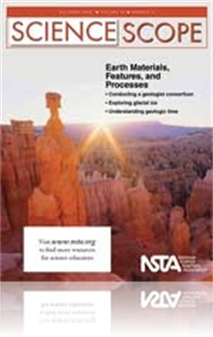All Science Scope resources
Journal Article
Scope on the Skies: No place like home
At a distance of 50.1 light years, the star 51 Pegasi represents an interesting milestone. When viewed today, the light you see from this star left the same year that President Eisenhower signed the National Aeronautics and Space Act (July 29, 1958)....
Journal Article
Science Sampler: Taking steps to understand geologic time
Getting students to understand the concept of geologic time is challenging because it is difficult to imagine the vast time frame of Earth’s history. Therefore, this article describes an inquiry-based activity that uses an experiential model to hel...
Journal Article
While most would agree wholeheartedly with the benefits of getting students out more, there are numerous challenges in doing so, ranging from shrinking budgets to a standardized test-driven scholastic environment. However, the Division of Interpretat...
Journal Article
Editor’s Roundtable: Developing inquiry skills
Inquiry skills cannot be taught in only one grade or taught only at the start of the year; and they cannot be taught by having students memorize a set of procedures and definitions for a pencil-and-paper test on “the scientific method.” To become...
Journal Article
Science Sampler: Engendering inquiry
There is a tendency to underestimate the abilities of students to conduct inquiry due to both inferred and actual student restrictions in the traditional school setting. While some constraints exist for viable safety reasons, other constraints placed...
Journal Article
Injecting Inquiry Into Photosynthesis Investigations
This is the story of how a typical middle school lab was transformed into an open-ended inquiry experience through a few small, but very powerful, changes. By allowing students to follow their own questions, the classroom filled with enthusiasm and s...
Journal Article
Teacher’s Toolkit: A blueprint for cultivating inquiry
Scientific inquiry, a methodology that can trace its roots back to the time and teachings of Socrates, has been an elusive and evolving part of our education lexicon for many years. The Socratic approach to teaching, in its simplest form, can be thou...
Journal Article
Tried and True: Helicopter seeds and hypotheses … that’s funny!
Investigating maple samaras, or helicopter seeds, can give students a “that’s funny” experience and catalyze the development of inquiry skills. In this article, the authors describe how to use maple helicopter seeds (samaras) to engage students...
Journal Article
The West Point Bridge Design (WPBD) building project engages students in project-based learning by giving them a real-life problem to solve. By using technology, students are able to become involved in solving problems that they normally would not en...
Journal Article
Developing the Essential Features of Inquiry
This lesson can be used at the beginning of the year to teach students how to conduct inquiries using the essential features described in Inquiry and the National Science Education Standards (NRC 1996). The lesson is divided into several activities w...
Journal Article
Science Sampler: How many lefties in our classroom?
Probability sampling is an interdisciplinary math and science skill that often serves as the precursor to conducting scientific research. This article describes a lesson that uses probability sampling to allow middle school students to investigate so...
Journal Article
Bernoulli’s Principle: Science as a Human Endeavor
What do the ideas of Daniel Bernoulli—an 18th-century Swiss mathematician, physicist, natural scientist, and professor—and your students’ next landing of the space shuttle via computer simulation have in common? Because of his contribution, ref...
Journal Article
Science Sampler: Caution! Scientists in the making
Equipping students with knowledge, skills, attitudes, and habits of mind necessary to design investigative questions is an essential goal for any science teacher. Just as with anything new, when students begin to design investigative questions, they ...



